I still remember the first time I tried to eat noodles with chopsticks. I was sitting in a crowded ramen shop in Tokyo—nervous, curious, and completely uncoordinated. My fingers fumbled. Noodles slid. I accidentally flung a piece of tofu into my broth. But I also remember the joy of finally getting it right—the satisfying clink of bamboo against ceramic, the confidence of lifting food with grace, and the smile from the chef who saw me try (and fail) and try again.
Learning how to eat with chopsticks isn’t just about mastering a utensil. It’s about respecting tradition, embracing discomfort, and connecting with a food culture that values precision, patience, and practice.
Whether you’re prepping for your first sushi night or want to impress at your favorite noodle spot, this guide will walk you through exactly how to eat with chopsticks—step by step, no judgment, just support. From proper grip to etiquette, we’ve got you covered.
🥢 Step 1: Understand the Parts of Chopsticks
Before you learn how to eat with chopsticks, it helps to know what you’re actually holding. Though simple in appearance, chopsticks are thoughtfully designed, and understanding their parts will improve your grip and control.

📌 The Basic Anatomy of Chopsticks:
- Tips: The pointed or tapered ends used to grab food. Some are textured for grip—great for beginners.
- Body: The main length of the chopstick. This is where the motion and leverage happen.
- Ends/Base: The thicker, blunt end where you hold the chopsticks. In Japanese dining, you never rest this end on the table.
Different cultures design chopsticks slightly differently:
- Japanese chopsticks: Shorter, often pointier, and lacquered.
- Chinese chopsticks: Longer with a blunt, square or rounded end—ideal for reaching shared dishes.
- Korean chopsticks: Flat and made of metal, offering unique dexterity (and a bit of a learning curve).
Knowing what you’re working with will make learning how to eat with chopsticks a lot smoother.
✋ Step 2: How to Hold Chopsticks Correctly
Getting comfortable with how to hold chopsticks is the foundation of learning how to eat with chopsticks like a pro. It’s not about strength—it’s about balance and finesse.
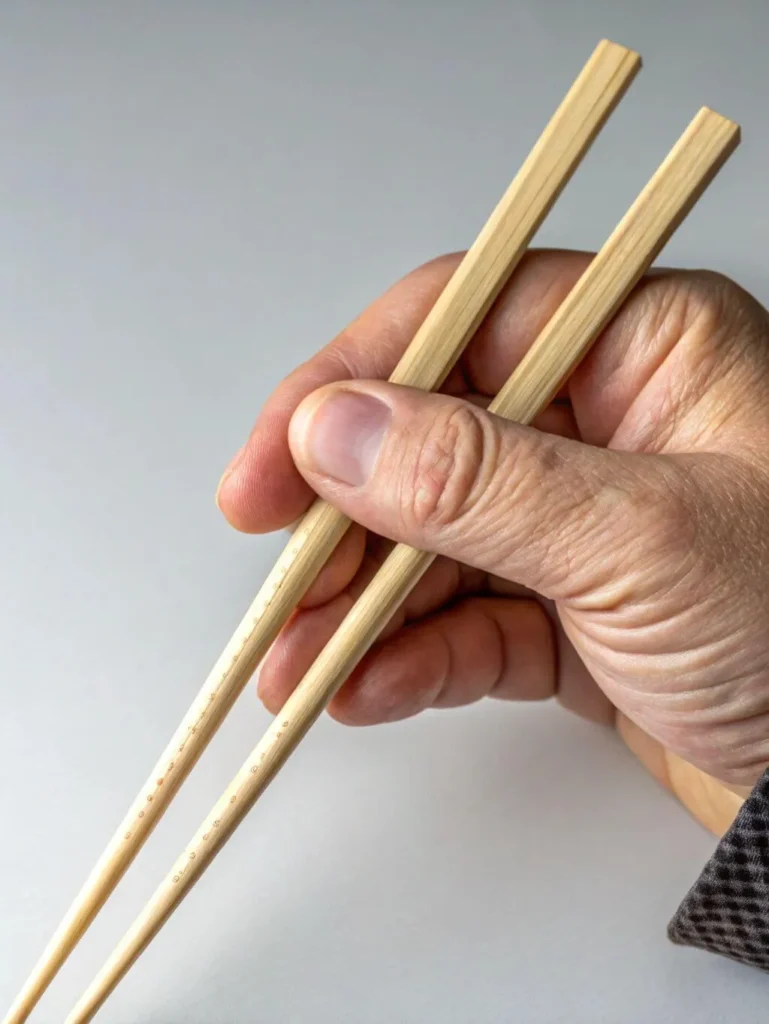
🪶 Step-by-Step Grip Guide:
- Rest the Bottom Chopstick
- Tuck one chopstick into the crook between your thumb and index finger.
- Let it rest against the base of your ring finger.
- This chopstick stays stationary—it acts like a lever’s base.
- Position the Top Chopstick
- Hold the second chopstick like a pencil—between your thumb, index, and middle finger.
- This is your moving chopstick. Only this one will pivot.
- Alignment Check
- Both chopsticks should line up at the tips.
- Your hand should feel relaxed, not stiff. If your fingers cramp, ease up your grip.
📌 Pro Tip: Start practicing with longer, textured chopsticks (like those used in Chinese restaurants). They’re easier to handle than smooth or metal varieties.
🤏 Step 3: How to Move the Top Stick
Learning how to eat with chopsticks isn’t just about holding them—it’s about how you move. This step separates frustration from finesse.
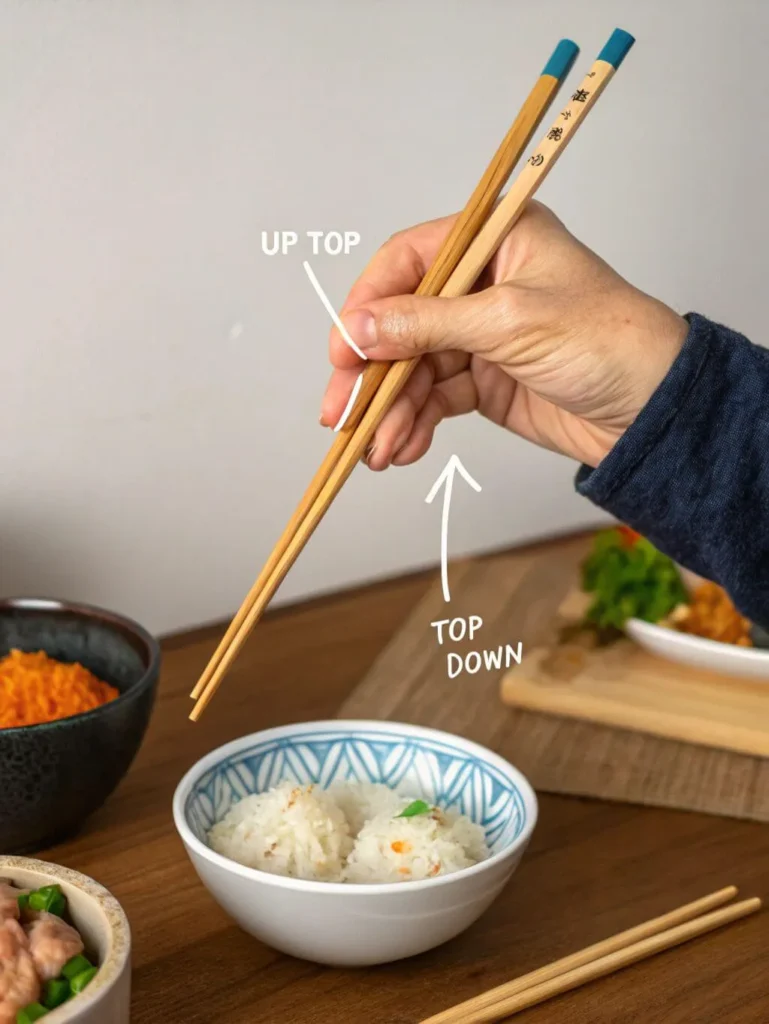
🧠 The Technique
When learning how to eat with chopsticks, the top stick is the only one that moves:
- Keep the bottom chopstick steady; it rests comfortably against your ring finger.
- Use your index and middle fingers to pivot the top stick up and down.
- Aim for fluid, silent movement—no clicking, snapping, or crossing.
If the tips of your chopsticks misalign, pause and readjust. A clean movement is key to mastering how to eat with chopsticks correctly.
🥄 How to Practice Movement
Start with small, manageable objects:
- Pick up cotton balls, pieces of dry pasta, or beans one at a time.
- Repeat until your motion feels smooth and natural.
It may feel awkward at first, but repetition is essential in learning how to eat with chopsticks. Take your time and celebrate every win—yes, even grabbing that first stubborn peanut.
📌 Why This Matters
Without this motion, eating is nearly impossible. Whether you’re pinching tofu or twirling noodles, this step is what allows you to apply all other techniques involved in how to eat with chopsticks.
Building finger control takes patience, but once mastered, you’ll feel the freedom and flow that makes chopsticks such a joy to use. That’s the real secret behind how to eat with chopsticks like a local—not perfection, but confidence.
🧲 Step 4: Practicing the Pinch
Now that your fingers understand the motion, it’s time to turn practice into precision. Mastering the pinch is the key to using chopsticks confidently and efficiently.
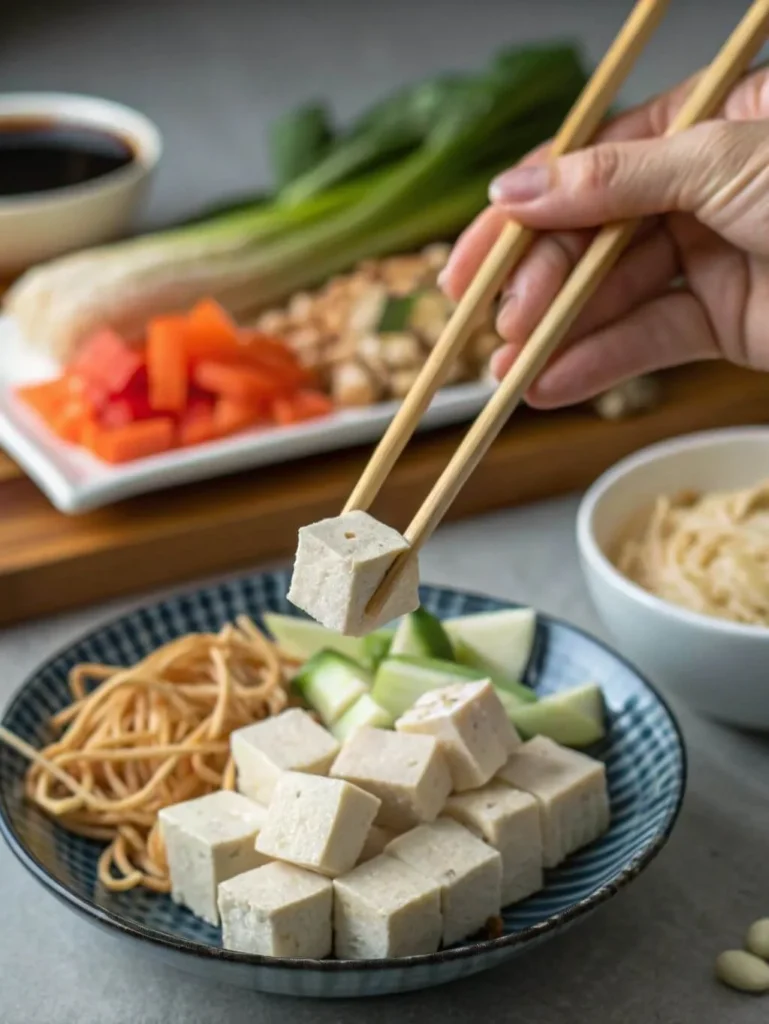
🍢 How to Pinch Properly
- Slightly lift the top chopstick to open the tips.
- Align and gently close them around your target.
- Squeeze just enough to grip—avoid pressing too hard.
- Lift the item straight up to maintain control.
It’s not about strength—it’s about steadiness. This stage transforms basic movements into useful action.
🧪 Beginner-Friendly Foods to Practice With:
- Tofu cubes or chunky veggies (like mushrooms or broccoli)
- Thicker noodles like Lo Mein or Ramen
- Slices of Homemade Noodles or Chow Mein
Practicing on easier foods helps you build confidence before tackling more delicate bites. It’s all part of learning how to eat with chopsticks gracefully and effectively.
🍲 Step 5: Picking Up Food – Noodles, Rice & More
Now that your grip and motion are solid, it’s time to apply what you’ve learned to actual food—the real test of how to eat with chopsticks confidently and calmly.

🍜 Noodles
Noodles are some of the most satisfying foods to eat with chopsticks. For beginners, start with thicker varieties like:
Use a scooping motion combined with a gentle lift. Let excess noodles dangle slightly to avoid flinging broth or sauce.
🍚 Rice
Eating rice with chopsticks can be tricky depending on the type. Sticky rice, like Japanese or short-grain varieties, is easy to grip in small clumps. Simply pinch and lift gently. If you’re eating from a bowl, hold the bowl close to your mouth and scoop rather than pinch.
Pro Tip: Don’t use chopsticks for loose or dry long-grain rice (like basmati)—it’s not culturally expected and can be frustrating.
🥢 Small or Slippery Foods
Want to test your skills? Try picking up:
- Peanuts or edamame
- Tofu cubes
- Stir-fried vegetables
These foods help sharpen your control, making your technique even stronger.
Mastering how to eat with chopsticks means knowing how to adapt your movement based on texture, weight, and shape. The more you practice, the more intuitive it becomes.
🎎 Step 6: Chopstick Etiquette + Cultural Tips
Once you’ve learned the technique, the next step in mastering how to eat with chopsticks is understanding the unspoken rules. Etiquette varies slightly across cultures, but certain practices are considered disrespectful in nearly all Asian dining settings.
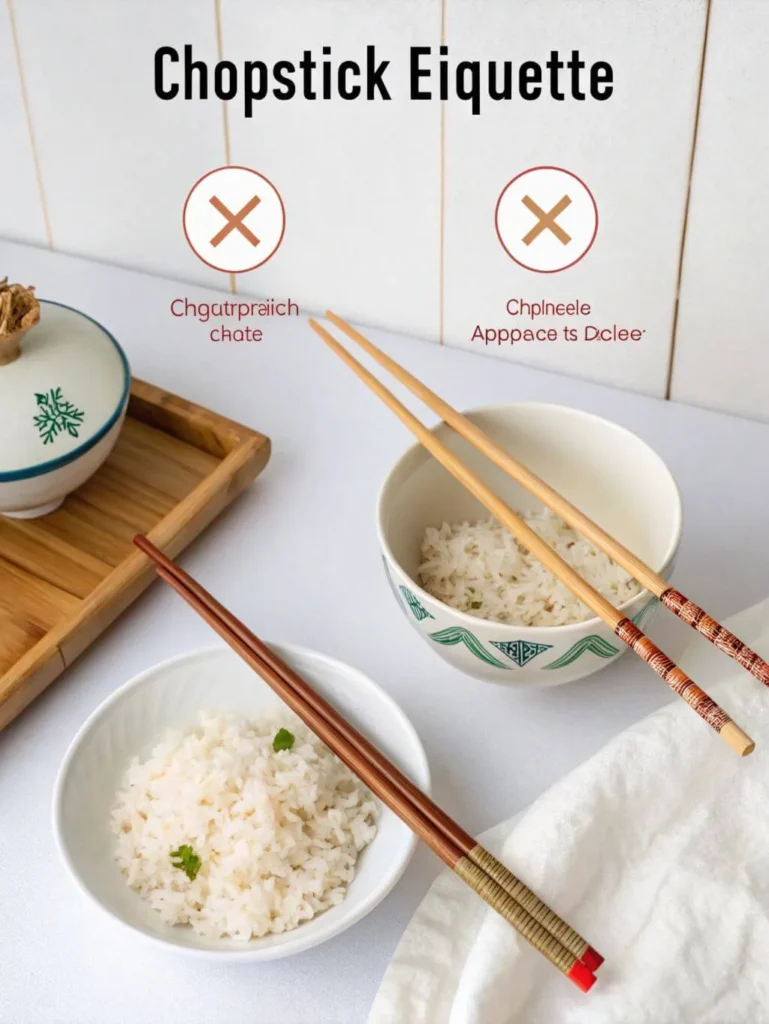
Summaries How To
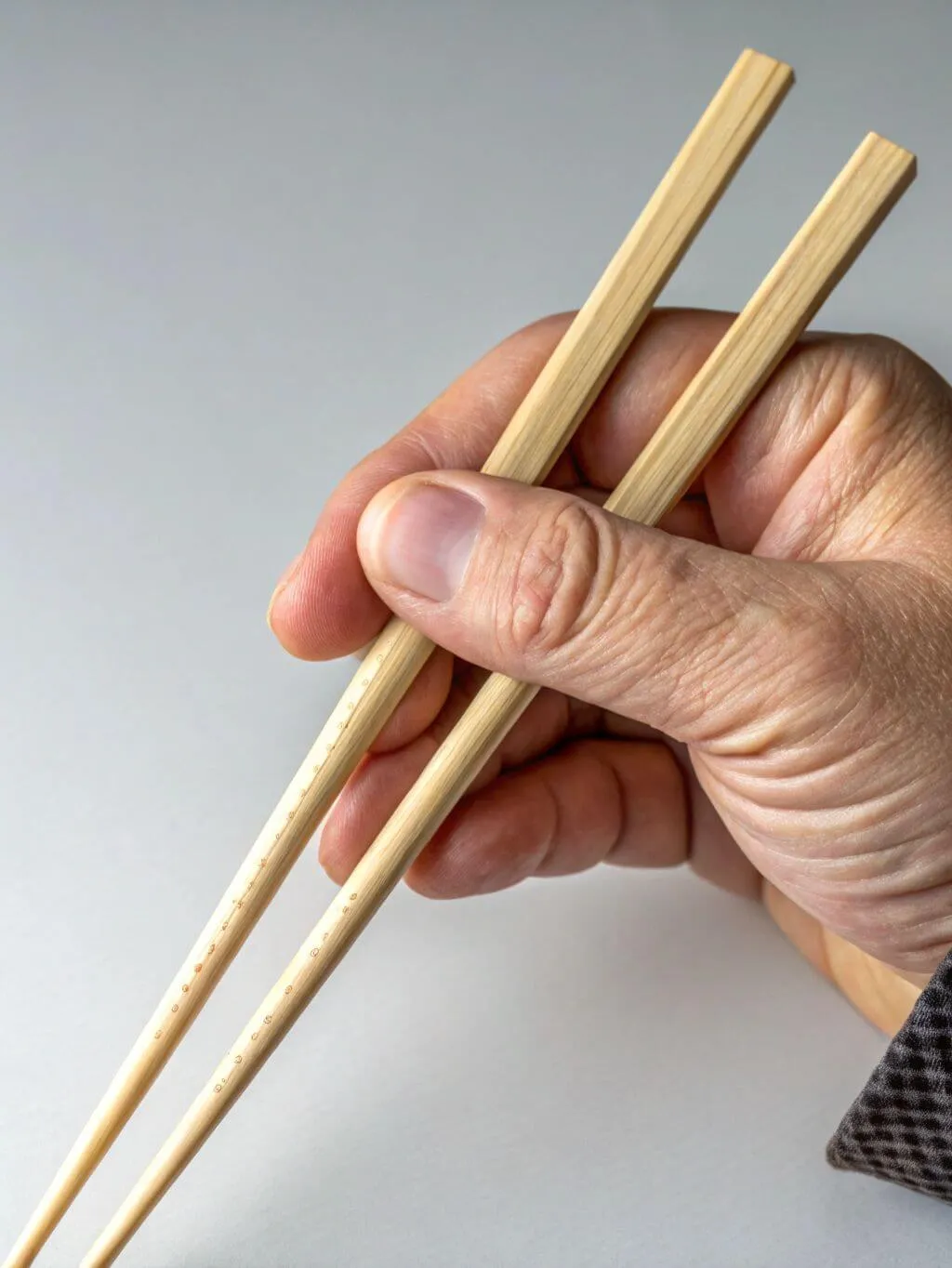
Learning how to eat with chopsticks isn’t just about mastering a utensil. It’s about respecting tradition, embracing discomfort, and connecting with a food culture that values precision, patience, and practice.
10 minutes 10 minutes
Hold the first chopstick

Place the first chopstick between your thumb and index finger…
Grip the second chopstick
Place the second chopstick like a pencil, above the first one.
Practice opening/closing

Move the top chopstick using your index and middle fingers.
Pick up food
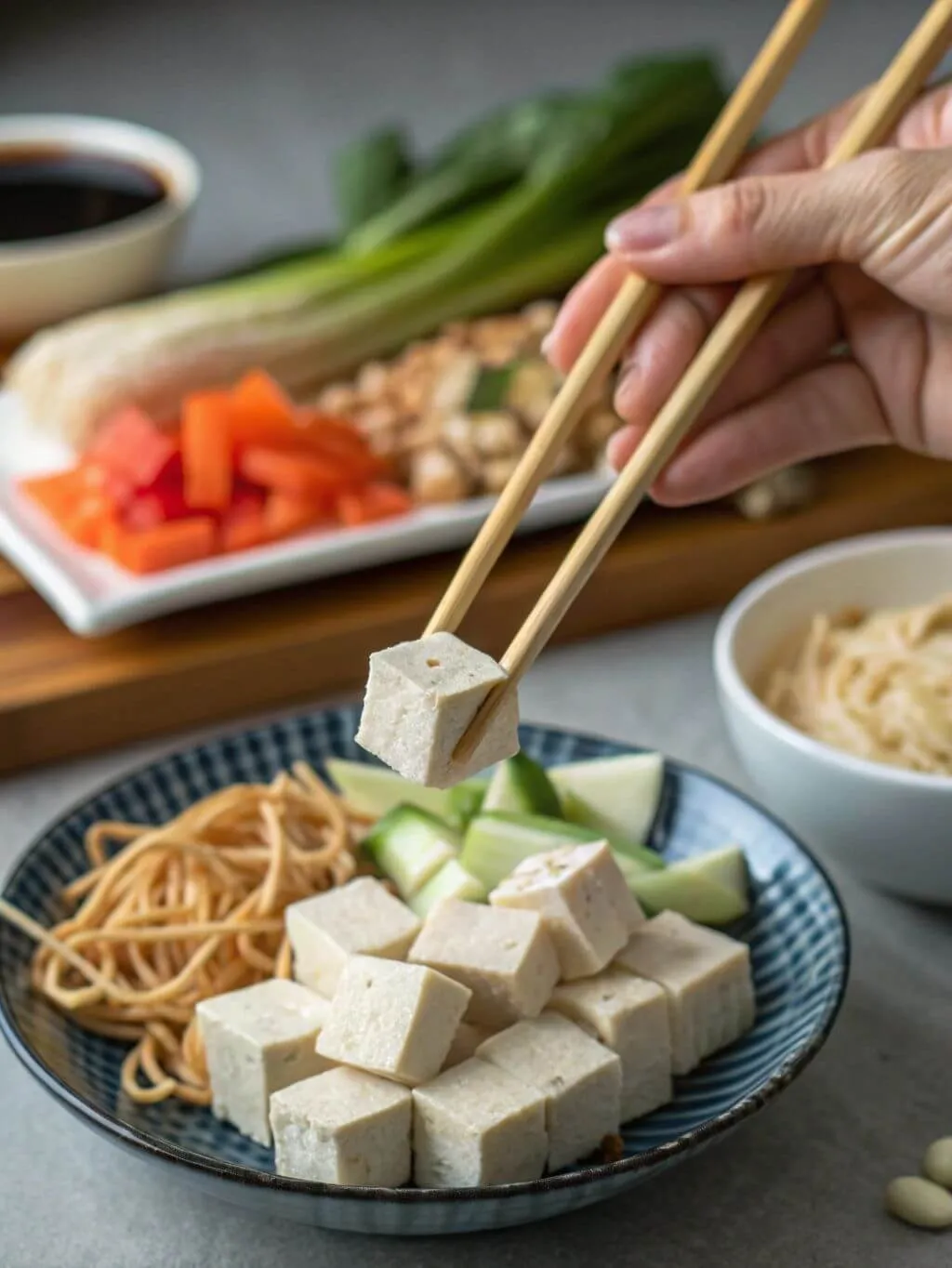
Try lifting noodles or rice using gentle pressure between sticks.
Estimated Cost: 1 USD
Supply:
- Pair of chopsticks
- Bowl of food (rice or noodles)
Tools:
- Your dominant hand
Materials: chopsticks noodles
🚫 What NOT to Do With Chopsticks
1. Don’t Stick Them Upright in Rice
This resembles a funeral offering in many Asian cultures. Always rest them horizontally or on a chopstick holder.
2. Don’t Rub Wooden Chopsticks Together
It implies the restaurant gave you cheap or splintered utensils—this can be seen as rude unless you genuinely see splinters.
3. Don’t Point with Your Chopsticks
It’s considered impolite to gesture or wave them while speaking.
4. Don’t Cross Them When Resting
Lay them parallel, never in an “X” shape, which symbolizes death in Japanese culture.
5. Don’t Pass Food from Chopsticks to Chopsticks
This mimics a funeral rite. Instead, place food onto a plate for others.
6. Don’t Use Chopsticks to Skewer Food
Use the proper pinching method rather than stabbing, which is viewed as childish or disrespectful.
7. Don’t Lick or Suck on Them
Chopsticks are tools, not popsicle sticks—avoid placing them deep into your mouth.
🌏 Cultural Notes: Japan vs. China vs. Korea
- Japan: Emphasizes clean, quiet eating and precision. Chopsticks often rest on ceramic holders.
- China: Often involves shared dishes; never dig through the dish with your sticks.
- Korea: Uses metal chopsticks. Spoon and chopsticks are often used together, especially for rice.
Respect is a huge part of how to eat with chopsticks—mastering etiquette shows appreciation for the culture behind the cuisine.
❓ Frequently Asked Questions
What are the 7 rules when using chopsticks?
The 7 key etiquette rules are:
Don’t stick them upright in rice (symbolizes death).
Don’t rub them together (seen as rude).
Don’t point at people or food.
Don’t cross them when resting.
Don’t pass food from chopstick to chopstick.
Don’t use them to stab food.
Don’t lick or suck on them.
These behaviors are considered disrespectful in many Asian cultures and essential to know when learning how to eat with chopsticks properly.
Is there an incorrect way to hold chopsticks?
Yes. Holding both chopsticks in one hand without anchoring the bottom stick properly, crossing them like scissors, or gripping them too tightly all make it harder to control your food. Correct technique is crucial to mastering how to eat with chopsticks with ease and respect.
How do Japanese people eat with chopsticks?
In Japan, chopstick use is precise and polite. Diners keep movements small, avoid noise, and often rest chopsticks on holders. They also never pass food from one pair of chopsticks to another, as it resembles funeral rituals. Learning these customs is part of understanding how to eat with chopsticks in a Japanese context.
Why do you rub chopsticks before eating?
Some people rub disposable wooden chopsticks to remove splinters. However, in most restaurants—especially in Japan—this is frowned upon. It can suggest that the utensils are cheap or poorly made. Unless absolutely necessary, skip the rubbing as part of polite chopstick use.
🏁 Conclusion – From Practice to Politeness
Learning how to eat with chopsticks isn’t just about technique—it’s about curiosity, cultural respect, and connection. Whether you’re trying noodles in a new restaurant, traveling abroad, or simply expanding your skills at home, mastering chopsticks opens the door to a more meaningful dining experience.
The slips, the fumbles, the tofu that gets away—they’re all part of the journey. And once you get the hang of it, you’ll wonder how you ever lived without the simplicity and elegance of chopsticks.
🍽️ Ready to Practice?
Start with foods designed for success:
- Lo Mein Noodles
- Ramen Noodle Recipes
- Chinese Chow Mein
- How Noodles Conquered the World – for cultural context
With every bite, you’re not just feeding your body—you’re honoring a tradition, engaging with history, and becoming part of a bigger food story.
So grab a pair. Practice. Slurp with confidence.
And celebrate the global beauty of eating with chopsticks.

